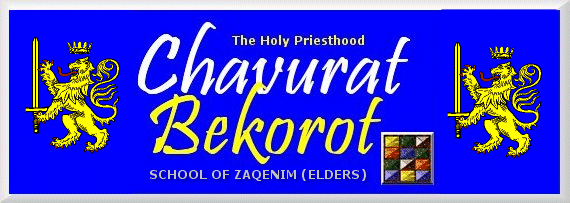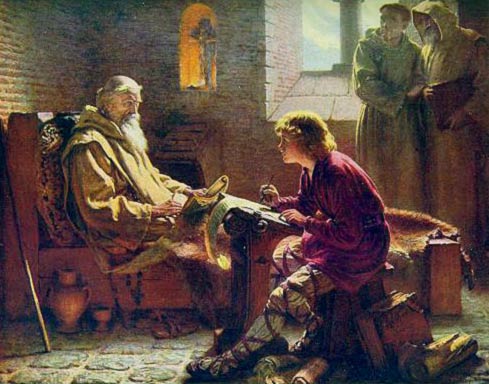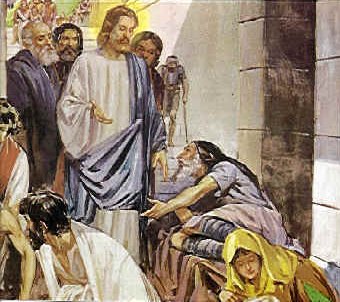
 4
JOHANNINE ESSAYS
4
JOHANNINE ESSAYS
 The Significance of Yah'shua's
The Significance of Yah'shua's
Healing Miracles
(19 October 1982)
by Christopher C. Warren, M.A.(Oxon)

Intro | 1 | 2 | 3 | 4 | 5 | 6 | 7 | 8 | 9 | 10 | 11
12 | 13 | 14 | 15 | 16 | 17 | 18 | 19 | 20 | 21
The story of the healing of the lame man by Yah'shua (Jesus) takes place on the Jewish Sabbath which provokes the Pharisees and other religious leaders to charge Him with a violation of the Law of Moses. Yah'shua (Jesus) refutes their claim, claiming that Yahweh, who is His Father, has never stopped working, even on the Sabbath, and thus justifies His own act of healing. This is an interesting point that reveals how the Law of Moses was altered by the Jews since the Babylonian Exile; the original commandment that Yahweh's people honour the Sabbath had never intended that no work should be done on the Holy Day, but rather that servile and unnecessary work be avoided. Work, involving acts of mercy and kindness on the Sabbath Day, were never banned by the Law of Moses. Thus the story of Yah'shua (Jesus) and the lame man clearly illustrates the extent to which the spirit of the Mosaic Law (Torah) had become encumbered with spiritless legalities that destroyed the very purpose of the Law. Yah'shua (Jesus) claimed that he had come to fulfil or complete the Law, to elevate the law of carnal commandments to a higher spiritual code epitomising the truth that He was Lord of the Sabbath and that the Sabbath was given to bless and not to enslave them.

The lame man seems therefore to have been a cog in a greater plot. He is used to trigger a dispute on the Sabbath but more importantly to focus the attention of the Jews on the weightier matters of the Law (Torah), namely faith and salvation. The lame man is restored to wholeness by the Messiah who uses the miracle to demonstrate the oneness between Himself and His Father, for without the Father He would not have been able to perform the wonder. Consistently the Jews fail to accept Yah'shua's (Jesus') submissive rôle with respect to the Father and seek to accuse Him of blasphemy by levelling the accusation that He is claiming equality with the Father. Yet salvation is no longer in observing the Law of Moses, which testified of Him, but in the person of Yah'shua (Jesus), who is the epitome of Torah.
The story of the blind man is, I believe, much more personal than that of the lame man. The latter seemingly does little to earn his restoration to health - he does not even confess Yah'shua (Jesus) as Messiah not does he appanetly exercise any faith in Him. He seems more of a pawn in a theological contest than the very focus of it. The blind man, however, demonstrates a very touching faith in Yah'shua (Jesus) and is not only cured physically but spiritually also. The lame man gains the whole use of his legs again, but the blind man recovers not only his physical sight but salvation too.
The blind man prompts Yah'shua's (Jesus') disciples to ask a theological question: "Who sinned that this man was born blind: his parents or the man himself?" A popular notion advanced by Pythagoras was that the kind of life a man lived before his birth on earth conditioned the circumstances in which he was born. But Yah'shua (Jesus) is not interested in the past - His mission is in the present. The man is blind both for his own salvation and for the benefit of those who will see him healed, giving Yahweh greater glory in both instances. The blindness is apparently to humble the afflicted man so that when Yahweh restores him, he will not only greet with wonder the ability to see the world but also be able to see the Messiah and the spiritual truth He brings. His appreciation for Yahweh is thus like Abraham's when his son is restored to him without the necessity, finally, to offer him up for sacrifice.
But there is another dimension to the healing of the blind man also. It was not uncommon in those days for necromancers to spit into blind people's eyes to attempt to restore their sight by reciting spells. Yah'shua (Jesus) is at the same teaching the message of the gospel demonstrating to the people that He has no need of spells and mischievous spirits (demons); He uses the ludicrously simple physical symbol, clay, which could have no healing qualities on its own, resorts to no spells, and calls instead upon the power of Yahweh to deliver the man. He dramatises the show to make the message sink deep into the minds of His audience, much as He was to do with the raising of Lazarus, telling the man to wash the clay from his eyes in the pool of Siloam. This must have reminded the Jews of the miraculous curing of Namaan who was likewise commanded to wash as a condition of being restored to health.
How is the blind man healed? By faith and obedience. The lame man obeyed Yah'shua (Jesus), it is true, but only probably because He was the only one who had ever offered to help him. The blind man, it seems, is touched by something within that leads him, bit by bit, to come to the realisation that Yah'shua (Jesus) is the Messiah. He is completely innocent and, like Nathanael, without guile, answering the questions of both the good and the bad with complete honesty. There is no deviousness in him. He is ripe for conversion. And when Yah'shua (Jesus) asks him if he believes in the Son of Man, he, in all his simplicity and honesty, asks who this Man is that he may believe. It takes only one word from Yah'shua (Jesus) to convince him - He believes, and in so doing is saved. He is filled with light while the Pharisees, who know only darkness and do not comprehend the light, dismiss the man as a double sinner - a sinner because of his parents and a sinner because of his former blindness. They fall into the trap that Yah'shua (Jesus) earlier warns the Jews against - that they should not judge according to the appearance, but judge righteous judgement (Jn.7:24).
So both men, lame and blind, have a rôle to play, though the blind man's would appear to be the greater. The idea of sight is linked with believing and comprehending in Yah'shua's (Jesus') world of symbology, and the blind man acts out the part perfectly - he sees in both senses. Arguably, his affliction was greater, and so was his reward greater too. For Yah'shua (Jesus), He has scolded those who abuse the Law of the Sabbath and brought home His message of salvation through instruments who have turned parable into reality. Yet with the parable beautifully revealed in living men the blind in heart continue to be blind. They are not the elect and cannot be saved anyway so why has Yah'shua (Jesus) bothered at all? He has come to gather the elect from amongst the tares - the wicked are reserved for Yahweh's judgement - Yah'shua (Jesus) has come to save, not judge. He never expected to convert the Pharisees because darkness has never accepted light. But now they are more guilty because they are not blind anymore - Yah'shua (Jesus) has worked before their eyes. They deny the testimony of their eyes and thus condemn themselves.
So we see in the story of these two men a spiritual revolution under way, one that is highly selective. In a sense the believers have always been believers but Yah'shua (Jesus) has come to awaken them, and the faithless have always been faithless, and they must remain to try those that believe. The concept of a chosen nation is done away with, the Jews cannot claim salvation by virtue of their lineage nor by performing dead, religious ordinances. The Jewish nation is divided as will all the Gentile nations be until the believers, wherever they may be, come together to form a new nation of Israel. We are witnessing in the stories of the blind and lame men the passing from one religious paradigm to another, the death of the diseased and the resurrection of the whole.
Intro | 1 | 2 | 3 | 4 | 5 | 6 | 7 | 8 | 9 | 10 | 11
12 | 13 | 14 | 15 | 16 | 17 | 18 | 19 | 20 | 21


This page was created on 6 February 2004
Updated on 6 February 2004
Copyright © 1987-2008 NCCG - All Rights Reserved



